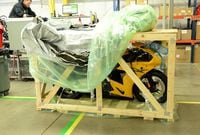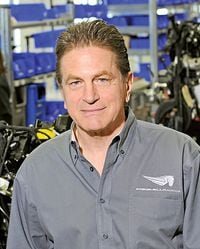When you talk to Erik Buell about his goals for his new firm, Erik Buell Racing (EBR), the phrase "pioneer engineering" comes up again and again. "The quintessential core of America has been this pioneering spirit," Buell says. "That's our American culture—a new land, a new form of government, all these different races and religions and backgrounds coming together and always adapting and changing. That's the American spirit; that's the pioneer spirit I want to apply to building motorcycles."
Even operating from this founding principle, Buell bristles at being pigeonholed as an "American" motorcycle manufacturer, and he has little patience for any talk of American exceptionalism. "I'm not about 'America, love it or leave it,'" Buell says. "Just because it's an American philosophy doesn't mean it's only found in America. You find it anywhere people are lean and quick and excited by challenges. We're getting engineers from around the globe—Spain, Germany, Japan, India—who are attracted to our flat, fast-paced company culture."
Make no mistake: Even though he's situated in America's heartland of East Troy, Wisconsin, Erik Buell's ambition and vision is global in scope, absorbing and applying ideas, technology, and talent from around the world to design and manufacture the best and most innovative motorcycles ever seen. Nowhere is this outlook more evident than in EBR's collaboration with India's Hero MotoCorp, which began as a small engineering consultancy and quickly expanded into a joint venture worth tens of millions of dollars, almost instantly catapulting Erik Buell from niche sportbike builder to one of the most influential voices in the future of motorcycling.
The odd couple EBR/Hero collaboration was born when a mutual friend introduced Buell to Hero Managing Director Pawan Munjal at the Daytona 200 in March 2011. Buell immediately recognized in Munjal a kindred spirit. "Pawan is a member of the family (Hero is a family-run public company), but he's also a really good engineer who worked in the trenches, just like me," Buell says. "He gets it instantly. He doesn't need a layer of people editing every move. He has the capability to act. You don't expect to find someone like that running a big company."
Hero had recently ended a 20-plus-year joint venture with Honda, and Munjal was assembling what he described to Gizmag.com as "an eco-system of technology research and development designed to think beyond the obvious and deliver future-ready mobility solutions." Creative and aggressive, EBR was a perfect fit. What started with a handful of product updates quickly blossomed into a full-blown collaboration. Hero paid $25 million last year to purchase a 49.2-percent stake in EBR, and 13 of the 19 new Hero motorcycles debuted at this year's New Delhi Auto Expo, everything from 100cc café racers to diesel-electric hybrid utility scooters to radical, hydrogen fuel cell-powered concept bikes, contained significant EBR DNA.
Diving into the global motorcycle marketplace has greatly expanded Erik Buell's thinking about two-wheeled vehicles, and the experience of work-ing with Hero has greatly expanded the capabilities—and the confidence—of EBR's design and engineering staff too. "So many of us are hard-core sportbike guys," says EBR Product Development Director Tony Stefanelli. "Hauling farm goods to market isn't something we spend a lot of time thinking about. How would you design a bike that might need to carry a family of five? Or a scooter, for a woman, riding in India? Working on these products wasn't hard from a technical standpoint, but getting inside the mind of a different customer was challenging—and fun."
The US is very isolated from the global motorcycle market, Buell says. Involvement with Hero gives EBR a truly global profile and access to markets where unit sales are measured not in hundreds but in hundreds of thousands. "Globally, the motorcycle market is huge," Buell says. "Hero builds more than 6 million two-wheeled vehicles per year! Our relationship with Hero gives us an opportunity to be part of that. It would not be the same opportunity if we were still working under Harley-Davidson. Am I having more fun now? I would have to say yes."
Despite the unceremonious end of his previous motorcycle company, Erik Buell remains in many ways loyal to and appreciative of Harley-Davidson, the company where he took his first engineering job in 1979. It's easy to say now that The Motor Company's decision to shutter Buell Motorcycles in 2009 was in many ways the best thing that could have happened to Erik Buell—he might even say so himself—but Buell is still quick to credit his time at Harley-Davidson with making him the engineer that he is today.
"I wouldn't be here if Harley-Davidson hadn't invested in me along the way," Buell says. "And Harley-Davidson is where I developed this style. It definitely wasn't easy to make a sportbike around a Harley-Davidson engine, so we had to come up with some really innovative and radical ways of doing things."
That ability to think unconventionally paid off when it came time to set up Erik Buell Racing and confront the seemingly insurmountable task of creating something from nothing—a world-class superbike from little more than some good ideas and a few leftover Buell parts. This is where EBR's quick acting, lean-operating team shined. "Those first projects went really well, really quickly, and we loved the results," Stefanelli says. "Why were we getting better results with less people and less money? It's because the team dynamic was different. We studied that, captured that, and wrote a document that we share with all new employees now. We actively talk about what kind of company we want to be."
Building a limited production, cost-no-object superbike like the $43,000 1190RS was relatively easy. Creating a mass-production version that can be built repeatably and reliably, and sold with a warranty to be ridden in an untold variety of circumstances, without sacrificing too much in terms of performance or quality, is something infinitely more challenging but something EBR's team was able to accomplish with the 1190RX in a re-markably short turn-around time.
"It's such a difficult process," Buell says. "The differences [between the RS and RX] are more than you would think—hundreds and hundreds of parts. A lot of the suppliers that were making parts in small quantities—or parts we were making ourselves—had to be changed to meet the volume we needed. To do this as quickly as we did, about a year since we got the funding in place, and to redesign and improve the bike at the same time, improving power and driveability and emissions like we did, is remarkable. To do all that with such a small group takes really, really good people. I have a really talented group here."
Racing remains important to Erik Buell, but it's hardly his only or even his primary focus—despite the company name. "Erik Buell Racing—EBR—was the only way I could use my name, since I couldn't use Buell anymore. Racing is our heritage, and an incredibly important part of my life, but we're obviously not just a racing company."
That said, for the first time ever EBR motorcycles will race in the World Superbike Championship this year, with a race team based in Italy. "Do we want to win?" Buell asks. "Of course, but that's not possible. Fielding a winning team is crazy expensive. That's not why we're there. We're doing it because we have a lot to learn. I don't want to turn my motorcycle into a half-million-dollar prototype. I want to see how close I can get with a motorcycle that's really close to what we sell. It's also a PR thing. There are a lot of EBR fans, and Hero fans, who want to see us on the world's stage."
In the meantime, things are booming back in East Troy. The EBR staff numbered 130 and growing at press time, with "legacy" employees from the former Buell Motorcycles accounting for roughly a quarter of that number. Staffing was closer to 60 a year ago, and around 10 the year be-fore that, indicating the pace of recent growth. Most of the staff are engineers; the consulting staff is the largest portion of the business. And the workload is hardly decreasing. EBR anticipates two more variants of the 1190 platform by the end of the year—most likely a streetfighter and an adventure-touring variation—in addition to an unspecified number of products under the Hero nameplate, for which EBR is the North American distributor.
Can EBR keep up this crazy pace? "That's why I set up the organization like this," Buell says. "I want it under stress. You become innovative under stress. I surrounded myself with people who love being in that environment. That's what we thrive on—difficult challenges with tight timeframes."
"When people say, 'You can't do that,' I say, 'Watch us.' We may not al-ways succeed. I'm okay with that. Just watch us."

























/cloudfront-us-east-1.images.arcpublishing.com/octane/S35YGSEMEZB4BLTDJTSZPF4GLA.jpg)
/cloudfront-us-east-1.images.arcpublishing.com/octane/5UOT6HPX2JFMRJAX6EH45AR4MQ.jpg)
/cloudfront-us-east-1.images.arcpublishing.com/octane/OKWOJWAKP5EP3OACCRRWPCIX2Q.jpg)
/cloudfront-us-east-1.images.arcpublishing.com/octane/2WF3SCE3NFBQXLDNJM7KMXA45E.jpg)
/cloudfront-us-east-1.images.arcpublishing.com/octane/G4MG6OUCJNBSHIS2MVVOTPX65E.jpg)
/cloudfront-us-east-1.images.arcpublishing.com/octane/IIGGWFOTOJGB7DB6DGBXCCMTDY.jpg)
/cloudfront-us-east-1.images.arcpublishing.com/octane/QSTCM6AVEZA5JJBUXNIQ3DSOF4.jpg)
/cloudfront-us-east-1.images.arcpublishing.com/octane/U4I7G625B5DMLF2DVIJDFZVV6M.jpg)
/cloudfront-us-east-1.images.arcpublishing.com/octane/B6XD6LS6IVCQPIU6HXDJSM3FHY.jpg)
/cloudfront-us-east-1.images.arcpublishing.com/octane/ICL63FEDDRDTTMINYICCEYGMDA.jpg)
/cloudfront-us-east-1.images.arcpublishing.com/octane/FCGZHQXRBZFLBAPC5SDIQLVF4I.jpg)
/cloudfront-us-east-1.images.arcpublishing.com/octane/WNOB6LDOIFFHJKPSVIWDYUGOPM.jpg)

/cloudfront-us-east-1.images.arcpublishing.com/octane/X33NU3E525ECRHXLNUJN2FTRKI.jpg)
/cloudfront-us-east-1.images.arcpublishing.com/octane/6KKT5NNL2JAVBOXMZYS5ZO76YA.jpg)
/cloudfront-us-east-1.images.arcpublishing.com/octane/J5RKG5O455GMPGQRF2OG6LRT7A.jpg)
/cloudfront-us-east-1.images.arcpublishing.com/octane/GX2CIZKQVRH2TATDM26KFG2DAE.jpg)
/cloudfront-us-east-1.images.arcpublishing.com/octane/ZWIDYSAKQZHD5BHREMQILXJCGM.jpg)
/cloudfront-us-east-1.images.arcpublishing.com/octane/CYUHJZCTSJCH3MRAQEIKXK7SCQ.jpg)
/cloudfront-us-east-1.images.arcpublishing.com/octane/LKOFINY56FCXJCANJ5M7ZDQUBY.jpg)
/cloudfront-us-east-1.images.arcpublishing.com/octane/4NBPDACMWJH63JQYJVK3QRBDZI.jpg)
/cloudfront-us-east-1.images.arcpublishing.com/octane/KKHQHRR3FJGX7H2IPU6RALMWG4.jpg)

/cloudfront-us-east-1.images.arcpublishing.com/octane/5IOFS5JAE5FOXMNA23ZRAVVYUU.jpg)